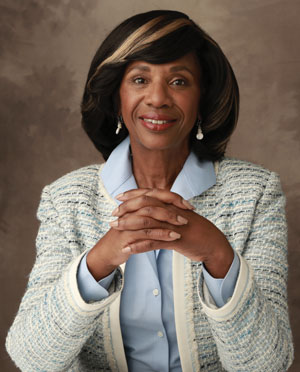Greater diversity and inclusion in the legal profession will help achieve justice for all

Photo of ABA President Paulette Brown by Marc Hauser.
The preamble to the United States Constitution promises to “establish justice.” In the Pledge of Allegiance, we vow “justice for all.” The American Bar Association motto states we are “pursuing justice.” Are they mere words on paper? Unfortunately, certain segments of society believe they are.
As author and poet Maya Angelou said: “Equal rights, fair play, justice, are all like the air; we all have it or none of us has it. That is the truth of it.”
We are all interested in justice and fairness in our country and in our world. Pursuing justice makes us better as a society. The lack of fairness does not just affect certain groups, it diminishes us all.
In the legal profession, diversity and inclusion, despite ongoing efforts, have fallen short of expectations. In our justice system, the events of the past 15 months have shone a spotlight on inequities that certain segments of society have endured for years.
Reliable data tells us there is an increasing lack of confidence in our nation’s justice system. According to a recent Harvard study, nearly half of young Americans, without regard to race, ethnicity or gender identity, believe the U.S. justice system has racial and ethnic biases. As lawyers committed to the pursuit of justice, we have the power to change these perceptions.
This year, the ABA will be proactive in rebuilding our nation’s confidence in the justice system. We will be true to Goal III of the four ABA goals: “Eliminate bias and enhance diversity.” The power and reach of the ABA will be leveraged to promote full and equal diversity and inclusion. We will leverage our power to end bias in the legal profession and the justice system.
To that end, we created the Diversity and Inclusion 360 Commission. Its mission is to review and analyze diversity and inclusion in the legal profession, the judicial system and the American Bar Association. And it will develop sustainable action plans, with accountability metrics and best practices to advance diversity and inclusion over the next 10 years.
A highly talented and diverse group of individuals has committed to take on this challenge over the next year. It includes experts from almost every sector of the profession including large law firms, solo firms, corporations, government, the bench, higher education and law schools. Collaboration with other groups and entities with similar goals is important to achieve the best results, and the Commission will work closely with these groups.
The Diversity and Inclusion 360 Commission will focus on four primary areas believed to be critical to advancing this goal. The commission will look within to determine how the ABA and its entities address diversity and inclusion, and will look to those entities to develop strategies, best practices and uniform guidelines. By doing so, the ABA can serve as a guidepost to assist state and local bars and other legal organizations, and foster diversity and inclusion through programs such as mandatory CLE.
The subtle and not-so-subtle prejudices we all may unconsciously hold can be an impediment to diversity and inclusion, and to a fair justice system. The commission will develop educational training materials for judges, prosecutors and public defenders to enhance their knowledge on the subject.
Only 12 percent of our profession is racially and ethnically diverse, making it the least diverse of all comparable professions. We must be more intentional in building a pipeline to colleges, law schools and, ultimately, to the profession. The path to the legal profession extends from kindergarten to bar passage. The commission will identify critical leaks in the pipeline and make recommendations for repair. It will then create resources to address the barriers to ensure a more representative profession.
Increasing financial opportunities for the full range of diverse lawyers is key for advancement. The percentage of female equity partners is inconsistent with their graduation rates, and lawyers of color accounted for only 7.33 percent of partners in the nation’s top 200 law firms in 2014. The commission will work to expand opportunities for them, and others, such as members of LGBT groups and those with various levels of ability, who have traditionally not been included in “in groups.” Economic success is an important component of the equation.
In the language of diversity and inclusion, we must be intentional in order to effectuate real and sustained change. We must abide by the words of the great civil rights attorney Charles Hamilton Houston and be “social engineers” for justice.
• Follow President Brown on Twitter @Brown4Lawyers.
This article originally appeared in the November 2015 issue of the ABA Journal with this headline: “Social Engineering: Greater diversity and inclusion in the legal profession will help achieve justice for all.”



